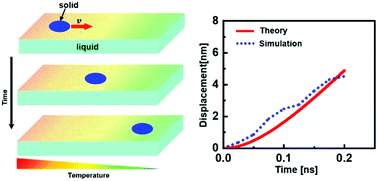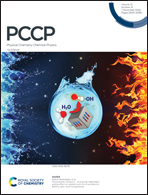Temperature gradient-driven motion and assembly of two-dimensional (2D) materials on the liquid surface: a theoretical framework and molecular dynamics simulation†
Abstract
The motion of two-dimensional (2D) materials on the liquid surface can be controlled by a pre-set temperature gradient. We propose a conceptual design of driving a graphene sheet on the water surface with a temperature gradient and demonstrate that both the velocity and orientation of the motion can be controlled by carefully assigning the magnitude and direction of the gradient of the liquid temperature. The driving force and friction force during the movement of the graphene sheet are derived theoretically by considering the temperature-dependent surface tension of water and the partial slip boundary condition between water and graphene. With this theoretical model, we predict the velocity and direction of the motion of graphene. Comprehensive molecular dynamics (MD) simulations are implemented to validate the theoretical predictions and the results agree well with the theoretical predictions. The motion and assembly of multiple graphene sheets are demonstrated to illustrate the potential application of the temperature gradient of the liquid surface in the manufacturing of low-dimensional materials into architected superstructures.



 Please wait while we load your content...
Please wait while we load your content...